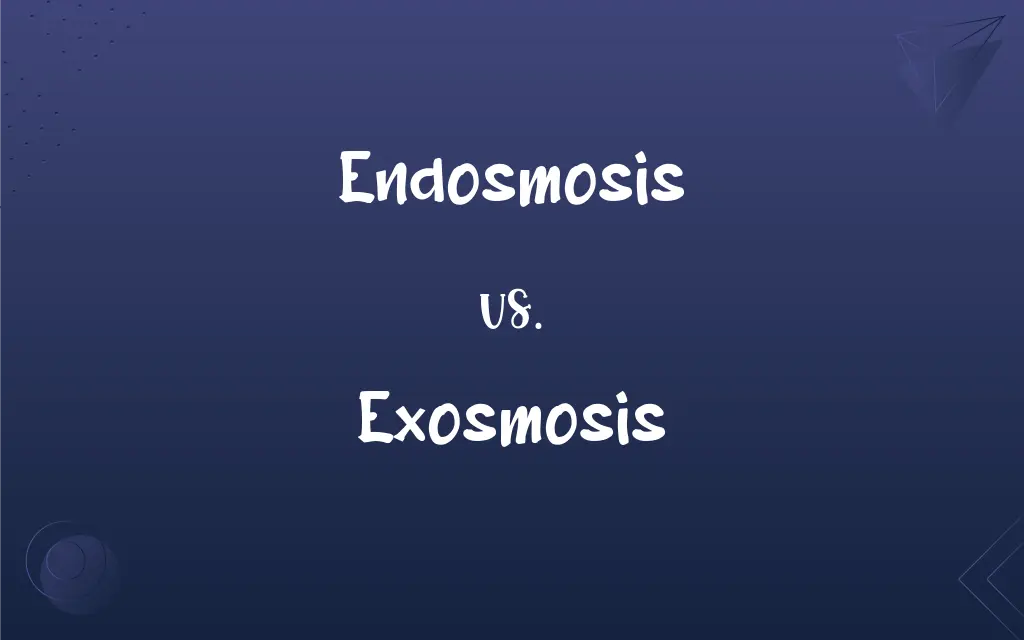Endosmosis vs. Exosmosis: What's the Difference?
Edited by Janet White || By Harlon Moss || Updated on October 27, 2023
Endosmosis is the movement of water into a cell or compartment, while exosmosis is the movement of water out of a cell or compartment.

Key Differences
Endosmosis and exosmosis are two processes involving the movement of water across a semipermeable membrane. Endosmosis refers to the movement of water into a cell or compartment, typically when the external environment is less concentrated than the internal environment. Conversely, exosmosis denotes the movement of water out of a cell or compartment, occurring when the external environment is more concentrated than the internal environment.
The direction of water movement in endosmosis and exosmosis is determined by osmotic pressure. In endosmosis, water moves inward to balance the higher solute concentration inside the cell, thus reducing osmotic pressure. In exosmosis, water moves outward, drawn by the higher solute concentration outside the cell, in an attempt to equalize osmotic pressure across the membrane.
Both endosmosis and exosmosis play crucial roles in maintaining cellular balance. Endosmosis allows cells to absorb water, vital for cellular processes and maintaining turgidity. Exosmosis, on the other hand, enables cells to expel excess water, preventing cellular swelling and potential damage.
While endosmosis and exosmosis both involve water movement, their consequences for a cell are quite different. Endosmosis can lead to cell expansion and turgidity, essential for plant cell rigidity. Exosmosis can cause cell shrinkage or plasmolysis, particularly in plant cells, if excessive water loss occurs.
Comparison Chart
Direction of Water Movement
Into a cell or compartment
Out of a cell or compartment
ADVERTISEMENT
Osmotic Pressure Influence
Moves water inward to reduce higher internal osmotic pressure
Moves water outward due to higher external osmotic pressure
Cellular Effect
Leads to absorption of water, increasing turgidity
Leads to expulsion of water, can cause shrinkage or plasmolysis
Environmental Condition
Occurs in hypotonic environments
Occurs in hypertonic environments
Role in Organisms
Important for cellular hydration and process
Crucial for preventing cellular overhydration and damage
Endosmosis and Exosmosis Definitions
Endosmosis
Endosmosis is the inward movement of water across a membrane.
Endosmosis caused the cell to swell in the hypotonic solution.
ADVERTISEMENT
Exosmosis
Exosmosis is the outward movement of water across a membrane.
Exosmosis led to the dehydration of the cell in the saline solution.
Endosmosis
Endosmosis increases cellular turgidity.
Endosmosis contributed to the plant cell's rigidity.
Exosmosis
Exosmosis balances external osmotic pressure.
Exosmosis helped the cell adjust to the external osmotic pressure.
Endosmosis
Endosmosis involves water absorption by cells.
Through endosmosis, the cell absorbed water and expanded.
Exosmosis
Exosmosis occurs in hypertonic environments.
In saltwater, exosmosis challenged the survival of freshwater organisms.
Endosmosis
Endosmosis balances internal osmotic pressure.
Endosmosis was vital in equalizing the cell’s osmotic pressure.
Exosmosis
Exosmosis can cause cell shrinkage or plasmolysis.
Excessive exosmosis resulted in the plant cell’s plasmolysis.
Endosmosis
Endosmosis occurs in hypotonic environments.
In freshwater, endosmosis helps amoeba regulate its internal water balance.
Exosmosis
Exosmosis involves water expulsion from cells.
To combat overhydration, the cell underwent exosmosis.
Endosmosis
The inward flow of a fluid through a permeable membrane toward a fluid of greater concentration.
Exosmosis
The passage of a fluid through a semipermeable membrane toward a solution of lower concentration, especially the passage of water through a cell membrane into the surrounding medium.
Endosmosis
Osmosis in which fluid flows through a membrane towards a region of higher concentration
Exosmosis
Osmosis in which fluid flows through a membrane towards a region of lower concentration
Exosmosis
See Exosmose.
FAQs
How do endosmosis and exosmosis differ in water movement?
Endosmosis moves water into a cell, while exosmosis moves water out of a cell.
What is exosmosis?
Exosmosis is the movement of water out of a cell or compartment across a membrane.
In what type of solution does exosmosis occur?
Exosmosis commonly occurs in hypertonic solutions.
What is endosmosis?
Endosmosis is the movement of water into a cell or compartment across a membrane.
Can exosmosis lead to dehydration?
Excessive exosmosis can lead to cellular dehydration and related issues.
In what type of solution does endosmosis occur?
Endosmosis typically occurs in hypotonic solutions.
Is endosmosis vital for plant cells?
Yes, endosmosis is important for maintaining plant cell turgidity and structure.
Are endosmosis and exosmosis passive processes?
Yes, both are passive processes driven by concentration gradients.
Does exosmosis always harm cells?
Not always; exosmosis can be essential for preventing cellular overhydration.
Do animal cells undergo endosmosis and exosmosis?
Yes, animal cells also experience endosmosis and exosmosis.
What regulates endosmosis and exosmosis?
Osmotic pressure and concentration gradients regulate these processes.
How does endosmosis affect osmotic pressure?
Endosmosis reduces higher internal osmotic pressure by moving water inward.
Can exosmosis be reversed?
Exosmosis can be reversed if the external environment becomes hypotonic.
Is endosmosis important for kidney function?
Yes, endosmosis plays a role in water reabsorption in the kidneys.
Can endosmosis cause a cell to burst?
In extreme cases, excessive endosmosis can cause a cell to burst due to overhydration.
What is the result of exosmosis in plant cells?
Exosmosis in plant cells can lead to cell shrinkage or plasmolysis.
Can human cells undergo plasmolysis?
Human cells typically do not undergo plasmolysis due to the presence of cell membranes rather than cell walls.
What role does endosmosis play in human health?
Endosmosis is vital for cell hydration and nutrient absorption in the human body.
Do cells control endosmosis and exosmosis?
Cells can regulate these processes through membrane channels and osmoregulation.
How does exosmosis affect osmotic pressure?
Exosmosis equalizes higher external osmotic pressure by moving water outward.
About Author
Written by
Harlon MossHarlon is a seasoned quality moderator and accomplished content writer for Difference Wiki. An alumnus of the prestigious University of California, he earned his degree in Computer Science. Leveraging his academic background, Harlon brings a meticulous and informed perspective to his work, ensuring content accuracy and excellence.
Edited by
Janet WhiteJanet White has been an esteemed writer and blogger for Difference Wiki. Holding a Master's degree in Science and Medical Journalism from the prestigious Boston University, she has consistently demonstrated her expertise and passion for her field. When she's not immersed in her work, Janet relishes her time exercising, delving into a good book, and cherishing moments with friends and family.































































